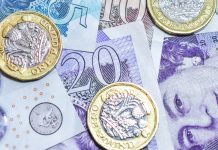- Pound (GBP) wage growth beats forecasts
- UK GDP data is due to show growth in April
- Euro (EUR) falls as German ZEW economic sentiment remains weak
- Eurozone industrial output is due
The Pound Euro (GBP/EUR) exchange rate is rising, extending gains from the previous session. The pair rose +0.44% yesterday, settling on Tuesday at €1.1680 and trading in a range between €1.1609 – €1.1694. At 05:35 UTC, GBP/EUR trades +0.07% at €1.1687.
The pound pushed higher in the previous session after UK jobs data showed that the UK labour market with more resilient than expected. Unemployment unexpectedly fell to 3.8% in the three months to April, Down from 3.9% undefined expectations of a rise to 4%.
Highlighting the strength in the labour market, the Office of National Statistics said that the number of people in jobs hit an all-time high of 33.1 million, up by 250,000 quarter on quarter as more Britons returned to the jobs market amid the cost-of-living crisis.
UK wage growth was also stronger than expected, 7.2%, up from 6.8% and ahead of forecasts of 6.9%. The data will unnerve policymakers at the Bank of England ahead of next week’s interest rate decision.
The central bank is widely expected to raise interest rates by 25 paces points. However, following the strong labour market data, the market expects the peak interest rate to be 5.75%.
Attention now turns to UK GDP data which is expected to show that the economy grew 0 .2% month on month in April after falling 0.3% in March. Strong growth could fuel hawkish BoE bets and lift the pound.
Meanwhile, the euro fell in the previous session after German inflation cooled to 6.1% in May and after German ZEW economic sentiment data deteriorated for a fourth straight month.
While economic sentiment was slightly better than expected at -8.5, up from -10.7, it remained negative, highlighting the gloomy near-term outlook.
Looking ahead, eurozone industrial output data is due and is expected to show that production increased by +0.8% month on month in April after falling -4.1% in March.





